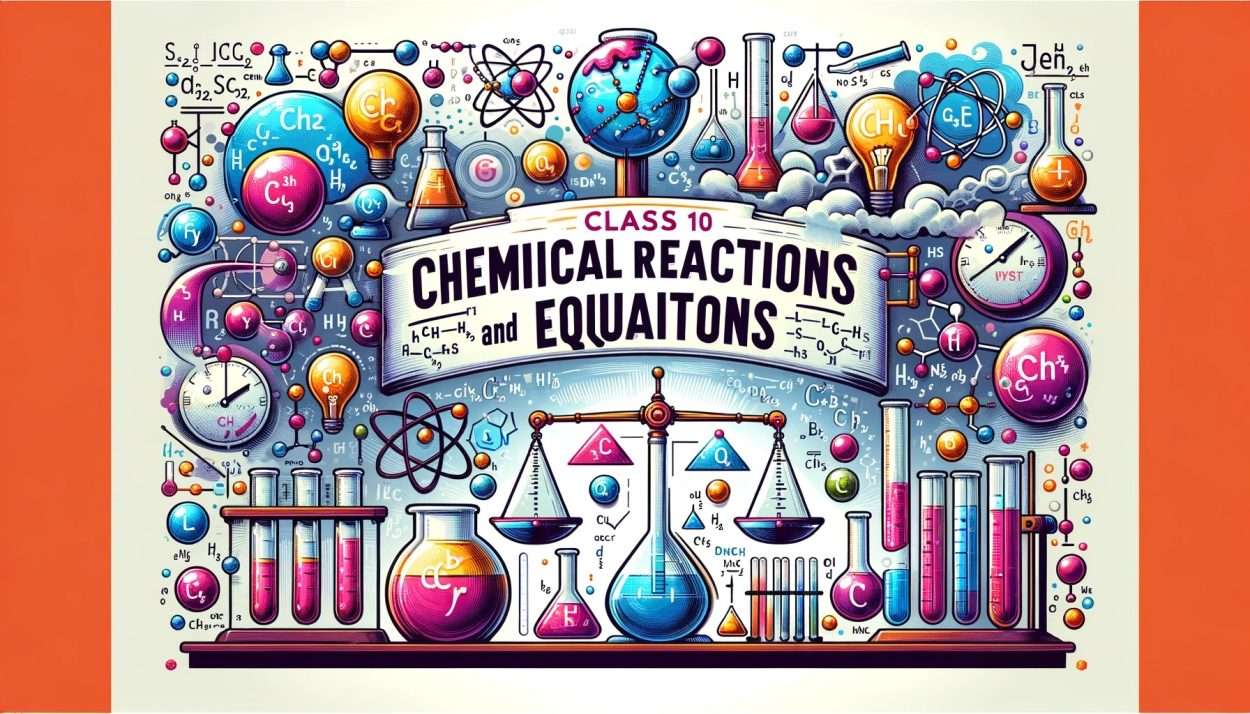
Class 10 Chemistry: Mastering Balanced Chemical Equations

Class – X th, Subject: Science
Question -Chemical Reactions and Equations Write balanced equations for the following reactions-
(1) Fe + H₂O FeO + H₂
(2) MnO2 + HCl → MnCl2 + H₂O + Cl₂
(3) HS+O₂→ H₂O + SO
(4) Fe₂O₃ + Al → Fe + Al₂O,
(5) Ca (OH)2 + CO₂→ CaCO3 + H₂O (6) ZnCO, ZnO + CO,
(7) Al+ CuCl₂ → AlCl + Cu
(8) AgNO3 + NaCl → NaNO3 + AgCl (9) NaOH + H₂SO₄ → Na XO + H₂O (10) N₂+ H₂→ NH,
(11) Mg+HCl→ MgCl₂ + H₂
(12) Fe + HCl → FeCl + H₂
(13) K+ H₂O → KOH + H₂
Explain above
- Iron reacts with Water to form Iron(II) Oxide and Hydrogen:
- Fe(s) + H₂O(g) → FeO(s) + H₂(g)
- This equation requires balancing in terms of the number of atoms on both sides. Since water is usually in the steam form when reacting with iron, it’s considered gaseous (g), and the reaction is often a part of the rusting process but in a very high-temperature context.
- Manganese(IV) Oxide reacts with Hydrochloric Acid to form Manganese(II) Chloride, Water, and Chlorine:
- MnO₂(s) + 4HCl(aq) → MnCl₂(aq) + 2H₂O(l) + Cl₂(g)
- This is a redox reaction where MnO₂ is reduced and HCl is oxidized.
- Hydrogen Sulfide reacts with Oxygen to form Water and Sulfur Dioxide:
- 2H₂S(g) + 3O₂(g) → 2H₂O(l) + 2SO₂(g)
- It’s a combustion reaction involving sulfur compounds.
- Iron(III) Oxide reacts with Aluminum to produce Iron and Aluminum Oxide:
- Fe₂O₃(s) + 2Al(s) → 2Fe(l) + Al₂O₃(s)
- This is a thermite reaction, generating a lot of heat.
- Calcium Hydroxide reacts with Carbon Dioxide to form Calcium Carbonate and Water:
- Ca(OH)₂(s) + CO₂(g) → CaCO₃(s) + H₂O(l)
- A typical acid-base reaction resulting in a salt and water, also illustrating carbonation.
- Zinc Carbonate decomposes to Zinc Oxide and Carbon Dioxide:
- ZnCO₃(s) → ZnO(s) + CO₂(g)
- This decomposition reaction occurs upon heating.
- Aluminum reacts with Copper(II) Chloride to form Aluminum Chloride and Copper:
- 2Al(s) + 3CuCl₂(aq) → 2AlCl₃(aq) + 3Cu(s)
- A displacement reaction where Al displaces Cu from its compound.
- Silver Nitrate reacts with Sodium Chloride to form Sodium Nitrate and Silver Chloride:
- AgNO₃(aq) + NaCl(aq) → NaNO₃(aq) + AgCl(s)
- A precipitation reaction where AgCl is the insoluble salt formed.
- Sodium Hydroxide reacts with Sulfuric Acid to form Sodium Sulfate and Water:
- 2NaOH(aq) + H₂SO₄(aq) → Na₂SO₄(aq) + 2H₂O(l)
- A neutralization reaction between a strong base and a strong acid.
- Nitrogen gas reacts with Hydrogen gas to form Ammonia:
- N₂(g) + 3H₂(g) → 2NH₃(g)
- Known as the Haber process, a critical industrial reaction for synthesizing ammonia.
- Magnesium reacts with Hydrochloric Acid to form Magnesium Chloride and Hydrogen:
- Mg(s) + 2HCl(aq) → MgCl₂(aq) + H₂(g)
- A metal-acid reaction producing a salt and releasing hydrogen gas.
- Iron reacts with Hydrochloric Acid to form Iron(II) Chloride and Hydrogen:
- Fe(s) + 2HCl(aq) → FeCl₂(aq) + H₂(g)
- Similar to reaction 11, but with iron as the metal.
- Potassium reacts with Water to form Potassium Hydroxide and Hydrogen:
- 2K(s) + 2H₂O(l) → 2KOH(aq) + H₂(g)
- A highly reactive alkali metal reacting with water, producing an alkali solution and hydrogen gas.
Each of these reactions demonstrates fundamental concepts in chemistry like redox reactions, decomposition, displacement, precipitation, neutralization, and synthesis. Balancing these equations ensures the law of conservation of mass is satisfied, meaning the number of each type of atom is the same on both sides of the equation.